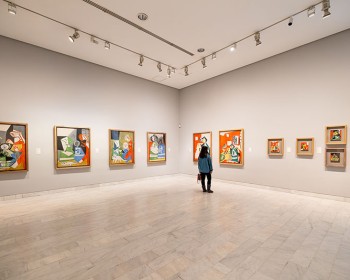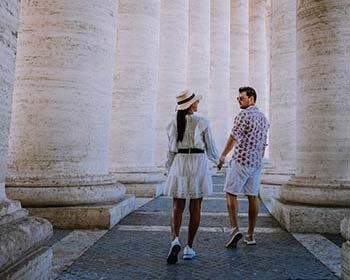There was a time when art existed even without Picasso. Then he came and turned it upside down. Art has never been the same after him..
Of course, he was not born a superhero. He had a childhood. Yes he did, like all of us. Born on October 25th 1881 in Malaga, he was the first child of Don José Ruiz y Blasco and María Picasso y López. Picasso’s complete name was Pablo Diego José Francisco de Paula Juan Nepomuceno María de los Remedios Cipriano de la Santísima Trinidad Ruiz y Picasso… Thank goodness he opted for a stage name. Pablo Picasso is defintely more functional.
He probably had art right in his DNA, since his father was a painter, becoming professor of art at the School of Crafts and curator in a local museum. Nevertheless, Pablo decided to use his mother’s surname… Mummy’s boy, like every first kid. And after all, this is how he was consacreted to the Olympus of the best artists of all times. Fair enough.
Picasso’s artistic skills showed up from an early age, when his father started giving him drawing and oil painting lessons by copying from the masters and accurately reproducing the shapes of human body. When Pablo was only thirteen, Ruiz felt that he had surpassed him and tried to push his son to give up painting. Obviously it did not work… But you probably know that!
The family moved to Barcelona in 1895, when Ruiz took a job in the School of Fine Arts. Picasso did not like life there, but Ruiz gave him a good reason to stay. Setting his little jealousy aside, he used his contacts in the academy to allow his son to try the exam for the advanced courses. This used to take students at least a month, but Picasso finished the exam in a week. He was admitted immediately, of course. Ruiz rented a small room for him and visited him frequentely, to have a look at his drawings. Picasso did not like to feel judged by his father, and they fought every time… Dad and son arguing is nothing special. Dad and son arguing over artistic disputes is so Picasso.
At the age of 16, Picasso was sent to Madrid’s Real Academia de Bellas Artes de San Fernando. As a boy he was intolerant of school rules and gave it up shortly after enrolement. A teen leaving school might seem quite ordinary, but this is where his climb to success began. Madrid had so much to offer to such a young artist, so he got the chance to start and get noticed.
Picasso was a very eclectic artist. He experimented with so many styles that speaking about all of them could be a little confusing. Luckily, his work is generally divided into periods. Let’s try to figure them out.
In 1900, Picasso went to Paris for the first time. His first stay in the Freanch capital did not last for long, but France was destined to be crucial in his life. Anyway, in 1901 he was back in Madrid. After returning to his motherland, he founded the magazine Arte Joven (Young Art) with his anarchist friend Francisco de Asís Soler. Picasso illustrated the magazine, mostly with cartoons sympathizing with the lower class. This is also when he started to sign his works as Picasso, a choice he made both because Ruiz was too common and to establish his independence from his father. Before he used to sign Pablo Ruiz y Picasso.
Meanwhile, a terrible tragedy struck him. One of his dearest friends, Carlos Casagemas, committed suicide and Pablo was completely traumatized by the event. His strong pain poured into his art, making his paitings melancolic, tormented and mostly coloured in monochromatic shades of blue. So it is no coincidence that the period between 1901 and 1904 is known as the Blue Period, in every sense.
On April 1904, Picasso moved back to Paris. Despite the lack of money, this was a very happy moment for him. In his studio, important personalities of the artistic panorama of that time gathered everyday, and they used to hang out altogether. This atmosphere of serenity and distress is displayed in his paintings, earning the next two years the name of Rose Period. It is characterized by cheerful themes of clowns, harlequins and carnival, painted in warm tones. He also started experimenting with primitivism, leading to another artistic period: the African Period. It all started when Picasso saw some African artwork in an ethnographic museum. The artist was so impressed, that in the next years his art was strongly influenced by African sculpture and traditional African masks.
The African Period has often been considered a Proto-Cubist phase. In 1907, the famous painting Les Demoiselles d’Avignon set a real turning point. Critics started to speak about its bizarreries cubiques (cubic oddities) and this is where the name of the movement itself came out. By 1911, Picasso’s artworks were acknowledged as the first Cubist paintings. Synthetic Cubism was a further development of the new-born genre. Less strict than the former style, it used highly innovative techniques like collage and papier collé, where paper fragments were pasted into compositions.
In February 1927, Picasso went to Italy. Maybe he was inspired by the Italian atmosphere, with all its recollections of ancient times and Renaissance… Who knows. As a matter of fact, in the following period Picasso made some works in neoclassical style. During the very last years of 1920s, the painter converted to Surrealism. Concern, fear and erotism are the leitmotives of his piantings in this period. We told you he was very eclectic. It was not a joke, it was an euphemism.
He kept on bouncing from one style to another for the next years, using art as a tool of political protest as well. During the 1930s, the minotaur replaced the harlequin in his work. He used the minotaur as a symbol of sorrow and anxiety, feelings which actually characterized those years of war and instability. Right in those years, he also released one of his greatest masterpieces – Guernica. The painting shows the inhumanity, brutality and hopelessness of the war spreading in Europe.
Around this time Picasso started writing, and he wrote over 300 poems and two full-length plays... You know, just to add a talent to his bright career and to make the rest of us feel a little bit more inept.
Oh, two more things. Picasso was also a successful sculptor. But maybe this does not impress you so much. Art was his specialty, you know that already. Anyway, this is not all. Hold your self tight now. Picasso made a few film appearances. Yes. While we are here living our lives like the mere mortals we are, Picasso was also a movie star. He was one of the best artists in history… And a movie star. And a writer. And some kind of god, arguably.
Pablo Picasso died on 8 April 1973, while he and his wife were entertaining friends for dinner. Even his death was perfeclty in line with his polyhedric life. Actually he did not die, he just bowed out. Do you still believe he was not a god?
Jokes aside, the artistic heritage he left is just immense. He was not just an important personality of the past century, he made history. Whether you are an expert or you do not care at all about art, you surely have heard about Picasso. Picasso was not an artist. Picasso was art. Picasso is art.
…and if reading about Picasso has raised your curiosity, do not miss the chance to discover his life and art through our amazing tours around Catalonia! Just go and have a look. At least you have not read all this for nothing. And by the way, thanks for your attention. You have been very patient.



